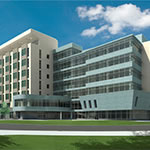At the Pappajohn Biomedical Discovery Building on the University of Iowa campus, researchers soon will be studying the causes, prevention, and treatment of diabetes and obesity. Which means the building itself has to be similarly healthy.
The project is just the latest undertaking for Rohrbach Associates, an architectural firm established in 1993 in Iowa City that has established a niche in green and sustainable construction for universities, especially on the University of Iowa campus. Whether renovating or retrofitting existing buildings or developing projects from the ground up, Rohrbach has set a standard for state-of-the art, LEED-certified design that has led to expansion beyond its traditional client base, higher education, and into the larger public sphere.
“We have several commissions with the University of Iowa, and they are very focused on requirements that come from the Board of Regents, as well as their own utility groups, to use sustainable … design,” says Steve Rohrbach, the president of Rohrbach Associates. “With some of our private clients—private healthcare or private commercial clients—the emphasis is not as strong and is only implemented for political or community concerns. But we’re finding more and more that communities are pushing clients to make every project, private or public, sustainable or some level of LEED.” Recently completed municipal projects and new ones on the boards—such as commercial high-rise, mixed-use developments, and a proposed hospital project—all utilize Rohrbach’s constantly evolving green approach.
The Pappajohn building represents Rohrbach’s green and sustainable practices at their best, particularly sensitive to the nature of the work that will take place in the building. The building’s wide range of needs in terms of air quality and energy use include the monitoring and regulation of not only laboratories, offices, and conference rooms, but also a 30,000-square-foot vivarium 14 feet below the surface of a courtyard. The air-monitoring system senses particles and particulates in the air throughout the building, determines the safety level, and then automatically adjusts airflow throughout the space if a hazard is detected. And the vegetative roofing, totaling more than 7,000 square feet, is a first on the University of Iowa campus.
The building envelope is key to the efficiencies of its systems, and Gene Keeton, president of KDENT, consulted with Rohrbach to create a continuous, watertight, airtight, and thermally tight envelope insulated on the exterior rather than interior. “That helps with the overall thermal effectiveness,” Keeton says. “When you put insulation on the interior of a building, you get thermal shorts through metal studs, so an R-value of 19 insulation in a six-inch steel stud cavity gives you an effective R-value of about seven. Whereas four inches, three inches of insulation on the exterior gives you a true effective R-value of 19.”
The local climate regularly experiences temperatures of -10 to -15 degrees Fahrenheit for extended periods, making all characteristics of the building’s envelope crucial. “We were very conscious of making sure that insulation was continuous, and also making sure that the glazing systems could effectively handle those kind of temperature ranges,” Keeton says. “We are talking about a continuous plane that, if you were to trace that plane from under the building, up one side across the roof and down the other side and back to your starting point, you would never have to pick up the pencil.” The project’s noteworthy features extend beyond the physical structure itself. Nine bus routes connect the Pappajohn building to the entire campus and surrounding communities, so no additional parking was added, and more than 75 bicycle racks are located in the vicinity.

